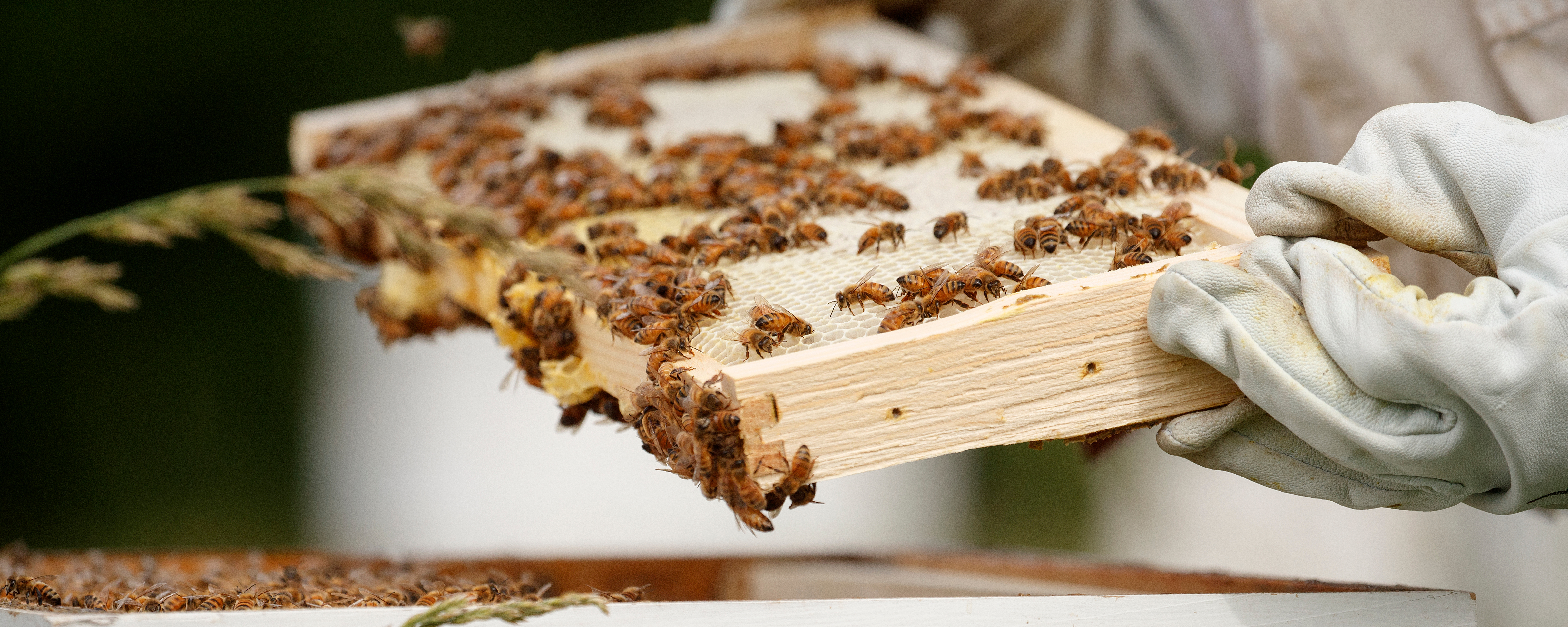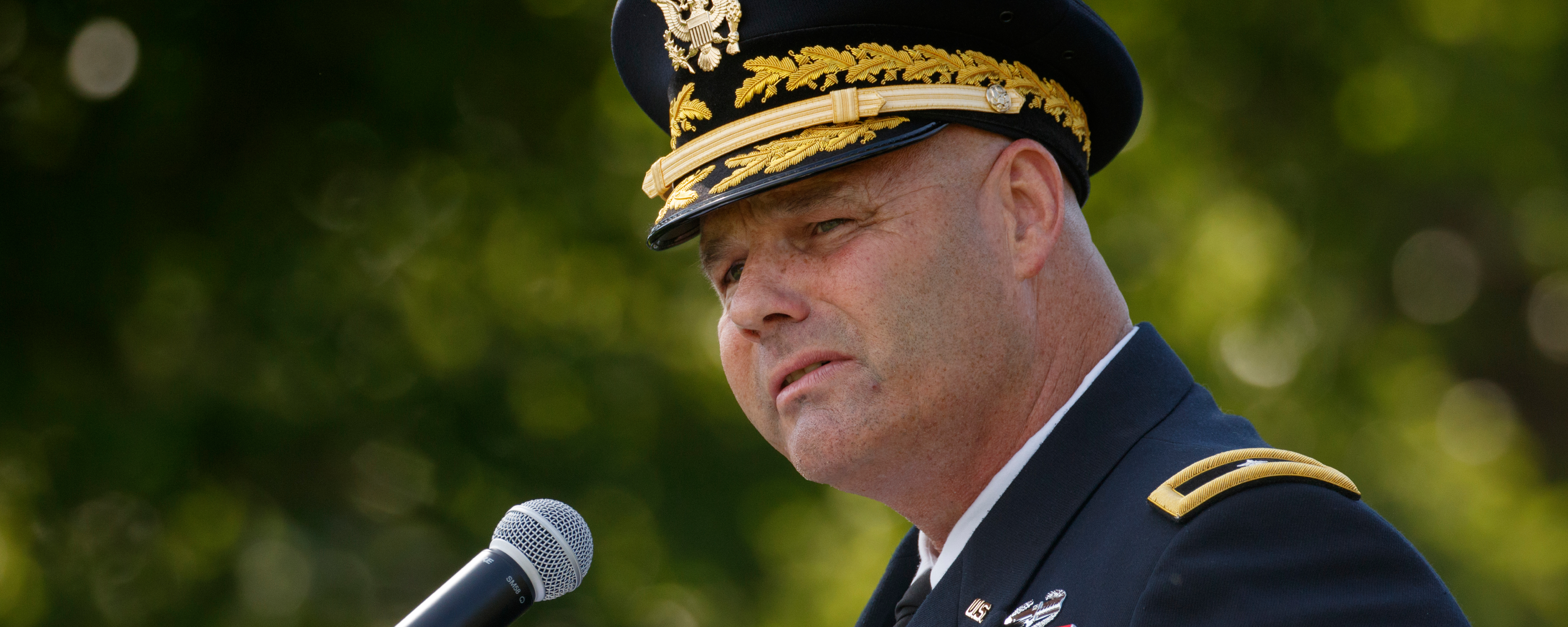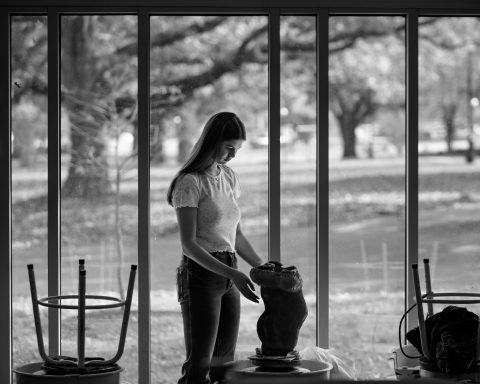The “buzz” about UT Martin’s beekeeping operation
Story by Erin Chesnut | Photos by Raffe Lazarian and Nathan Morgan
Students come to UT Martin to prepare for careers in agriculture, education, criminal justice, music, engineering and a host of other academic specialties. However, a small group of students is also taking part in a unique learning opportunity that’s creating quite the “buzz” on campus.
These students are learning the art of apiculture – the keeping of bees – in UT Martin’s newly enlarged apiary, located on the UT Martin Teaching Farm. An “apiary” refers to a place where bees and their hives are kept, and UT Martin’s 20 hives are full of European honey bees, the most common type of honey bee found in the United States.

While this project is not associated with any particular major, the half-dozen students who participate come mostly from the agricultural sciences. According to Dr. Kevin Pitz, professor of biology, these students are not only learning an interesting skill, they are also adding value to each garden in the Martin area.
“Honey bees, as far as agricultural pollination goes, are huge. … A lot of fruits and vegetables, the ones that produce flowers, are going to be pollinated by honey bees,” he said. While honey bees do not spend time pollinating the corn and soybeans that dominate West Tennessee’s farmland, they are still a vital member of the ecosystem that puts food on kitchen tables across America.
“What’s interesting is that the European honey bee is not native (to the United States), but it’s become highly integrated into what we expect as far as pollination goes in our agricultural systems,” said Pitz. “Even though they’re not native, it’s one of those weird situations where we don’t think too strongly about the implications of having brought a non-native (species) in because it is so beneficial to what we do here with all the other non-native things we grow as crops.”
Drivers along the north edge of the UT Martin campus have noticed the white beehives near Hyndsver Road for years, but what started off as 10 hives maintained by the Northwest Tennessee Beekeeper’s Association grew to 20 hives in March 2017 when Mike Pierce (’03), UT Martin’s farm manager and resident beekeeper, became involved with the project. Having kept honey bees himself since 2010, Pierce saw an opportunity to add value to the UT Martin acreage and pass a useful skill along to interested students.

Kiersten Bell, a sophomore from Pickerington, Ohio, and Travis Prather, a senior from McKenzie, have spent many hours in UT Martin’s apiary since it was expanded and had a hand in the establishment and maintenance of the new hives.
“You get (the bees), and they are in a mesh box. You can transport about three pounds of bees in these little boxes, and they come with a queen and about a quart of sugar water to keep them going throughout transportation,” said Bell. “After you get them put into the hive, they are pretty self-sufficient. We have been feeding them sugar water about every other day just to get them built up so they can make it through the winter.
“We do routine maintenance and make sure they have enough space – that they aren’t overcrowded. … You can have too much space, but if you have too little space and (the bees) are too overcrowded, there’s a good chance of them splitting. Half of them will go off and find more space, so you can potentially lose part of your hive if you aren’t paying attention to your space situation,” she said.
Bell began the project with a basic background knowledge of bees after spending time with an uncle who has several hives. However, Prather “might have been able to identify a bee if it stung him,” said Pierce.
“I didn’t know a single thing about a bee,” Prather said, grinning. He admits to having simply been in the right place at the right time to be recruited to the beekeeping project, but now views the experience as something that could follow him into the future.
“I have really enjoyed it, and as I started learning more about (beekeeping) … it was more interesting and seemed like something new every time,” he said. “It’s something I hope to keep learning about and maybe someday have my own beehives, too.”
While UT Martin’s 10 original hives are yielding excess honey this year, the new hives are working steadily to prepare for their first winter. Pierce says this process is more labor-intensive than most people realize, since the bees first have to create – or “draw out” – the honeycomb that will hold their food and offspring through the colder months.

“The (new) hives had no drawn comb in them. The drawn comb is like gold; they can’t do anything to function without it. The queen can’t lay (eggs); they can’t store nectar; they can’t store pollen. So all the functions of their lives revolve around having a place to put their resources,” he said. “That’s one reason we feed them so heavily is because they’re drawing out that comb. It takes toughly six to eight pounds of honey to make a pound of wax, so drawing wax is very labor-intensive for those bees, knowing that a hive usually goes through the winter with 40-50 pounds of honey (stored) to survive the winter.”
Many of these hives have already filled three to four “supers” – the stacked boxes that make up a beehive – with drawn comb. The bottom supers, which are also the largest, will hold the honey needed to sustain the beehive itself as well as the bee’s brood. Any excess honey created next year will be stored in the upper, smaller supers. Pierce hopes to begin harvesting excess honey from these newer hives in 2018.
Honey bees have made national headlines more than once in the past year as concern spreads regarding their population numbers and health. However, Michael Wilson, with the University of Tennessee Institute of Agriculture, says it’s not time to panic.
“For the honey bee to go extinct would … totally change the way we live, but I don’t think that would be realistic without some kind of major disaster like a nuclear war or something like that,” he said. Bee populations fluctuate naturally, and Wilson, who specializes in honey bees, says about 40 percent of colonies die out each year.

Invasion of the parasitic varroa mite – a honey bee’s primary threat – is the driving reason for colony loss. However, poor beekeeping habits, lack of space or foraging materials and other invasive predators such as hive beetles also contribute to colony death. Bees themselves only live for a few weeks in the summer, so new eggs must constantly hatch to sustain a colony’s population. To counteract this loss, beekeepers must keep a close eye on the status of individual colonies and will often split them up to create new hives and keep population numbers stable.
However, if the United States’ honey bee population were to drop too far, Wilson says it could begin to affect the consumers’ bottom line.
“It could get more expensive to buy good-quality goods that require pollination. It could be more difficult, particularly in the United States, to grow those kinds of foods to compete with other countries that might be growing food for a cheaper price for other reasons,” he said.
While prices at the grocery store would likely rise as honey bee populations decrease, there are other native pollinators such as butterflies, some types of wasps and other bees that could step up to fill the void.
“We’re not going to lose an agricultural industry, but there’s going to be an impact,” said Pitz. “What the impact is, we really don’t know because we don’t know how the natural ecosystem is going to account for (the decrease in honey bees). What’s going to step in to fill the role if that role is not being filled by honey bees? There are native organisms that obviously have the capacity to do it.”
Some groups would like to end the practice of keeping bees agriculturally and instead advocate to allow bee colonies to survive without the assistance of mankind. However, Wilson maintains that organized beekeeping is a vital component to keeping bee colonies healthy and active.
“Beekeepers are farming, which is different than a natural ecosystem. … Before settlers from Europe came to the Americas, the honey bees were not here. They were an introduced species for agriculture,” he said. “So if we were to stop managing the bees and keeping them as agriculture, … they could still exist in the wild, because they are capable of doing that, but in much lower numbers. You wouldn’t be able to produce decent crops that require pollination, … (and) you don’t have to be large-scale (to benefit from honey bees). If you have three or four acres of squash and don’t have any honey bees, you’re probably missing out on quality and yield.”
Wilson also says the proper harvesting of excess honey from a beehive is actually helpful to the bees and allows them to focus on providing for their colony.
“If you’re a beekeeper and you’re taking honey, you’re going to do it in a way that’s not going to kill or harm the bees so you’ll still have your bees next year when it’s time to get honey,” he said. “There are a lot of cases when you really need to get the honey off the comb. … If a colony has more honey than it can take care of, it can actually die because it has more honey than it can protect from the hive beetles. … It’s a timing-dependent thing. (Bees) need more honey through the winter, but in the spring they need that extra space available to raise more bees.”

There are many ways the average citizen can help keep the honey bee population healthy, even without raising their own hives. Wilson encourages residents to take advantage of campaigns like that run by the General Mills cereal company, which manufactures Honey Nut Cheerios, to send wildflower seeds to anyone who wishes to support honey bees.
Intentionally planting flowers to support honey bees “makes people more conscious of what’s in their yard and what they’re planting,” says Wilson. “If you’re somebody who’s planting seed packets or flowers for bees and, at the same time you’re spraying herbicides to kill wildflowers in your yard, it might make you stop and think about that. … Think about promoting having flowers instead of trying to get rid of them.”
Wilson also says that, while large-scale pesticide use is not the leading cause of honey bee death, small-scale usage by homeowners can be just as detrimental overall.
“There are a lot of actions people take that are unnecessary that actually cause harm to bees, such as using pesticides in their landscaping. They’re not trying to grow food; they may just want their grass to look green instead of having white and yellow flowers in it. It would be better for bees if people allowed flowers to grow,” he said.

State and federal budgets could also be impacted by the cultivation of honey bee habitats and forage areas.
“(Tennessee) spends a lot of money mowing along the roadsides, but other states are looking into how they can fit in more permanent flowers and plants so they don’t have to mow as much. They’ll save millions of dollars while improving the habitat for bees,” he said.
While some UT Martin students are doing their part to raise healthy honey bees, they are also gaining valuable knowledge and hands-on experience they can take with them into their future careers, whatever they may be.
“(Beekeeping) teaches you certain things, certain skillsets like attention to detail. It teaches you the value of really managing something properly and seeing the end reward of that. Being able to influence the hives and later on to collect the honey, to see it be bottled and labeled and sold and knowing that you were a part of that – it’s a pretty rewarding feeling,” said Prather. “You can use that for other things as well. When you go to managing a cattle field, you already know the feeling of, ‘If I work hard, the end result is going to be well worth it.’” Prather plans to graduate in the spring of 2019 and hopes to apply his farm and ranch management degree to the management of a cattle operation.
Bell leans toward the business-management side of agriculture, but believes her experience with the UT Martin apiary will allow her to help educate her future clients, coworkers and community about the importance of honey bees and proper pollination.

“If you have that little bit of background knowledge, you can share that with someone else. Then when they have a better understanding of it, they might go on and spread it, too. It’s a domino effect,” she said.
Pierce is proud of what his students have learned in such a short time and joins Bell in the hope that their experiences will help educate the larger population.
“Bees pollinate so many of the crops that we utilize as human food. …The more educated beekeepers that we have and the more people that are interested – even if they aren’t managing a hive – then the more people who have a better understanding and are more educated to talk to the public about pollinators and their importance in agriculture.”
Honey from the UT Martin hives is being collected as available and will soon be sold in the campus bookstore as well as at football games and other public events to support the apiary project and raise awareness about the importance of local pollinators, such as honey bees. Whatever the ultimate outcome may be for these busy insects, we can be sure UT Martin is doing its part to keep the “buzz” alive.










